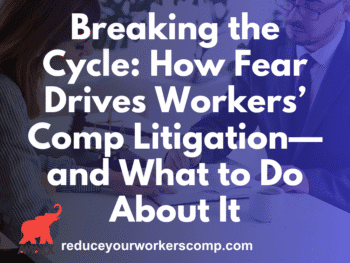Workers’ comp legal defense expenses are increasing at an alarming rate. For instance, California Workers Compensation – Aon Advisory Bulletin from a study by WCIRB of California, said allocated costs (mostly attorney payments) increased 7.3% in 2013.”
Overzealous defense counsel and untrained (or spineless) adjusters can prolong litigation, increase costs and wreak havoc on the lives of injured workers. Let’s take a look at how risk managers can more closely manage the process.
1) Review outside counsel financial arrangements.
Consider capped fees, flat fees, or “invoice paid upon file completion.” The latter allows outside counsel to defend the claim but discourages runaway fees for unnecessary hearings by having the entire fee paid at the end. With just one bill instead of monthly bills, excessive fees are more noticeable and easier to compare against other cases and law firms. It makes attorneys who are milking the claim more visible.
Click Link to Access Free PDF Download
“Avoid the 3 Primary Reasons Injured Workers’ Hire Attorneys”
This is a good approach if you use the same attorney frequently. However, this approach should not be used in a locale where the defense counsel only has one case. You could end up with an excessive bill with little recourse other than fighting over the bill.
2) Conduct an independent audit to assess whether an attorney was needed in the first place, or whether they have just been assigned the case to do work the adjuster was too busy to do.
A favorite ploy of overworked or lazy adjusters is to let the defense counsel handle everything. Don’t pay a lawyer to do the adjuster’s job. An independent claims audit will uncover any such problems.
Are the same attorneys requesting hearings on the same issue repeatedly or requesting hearings on issues they are likely to lose? E.g. if terminated benefits are often reinstated at hearings, it indicates that benefits are being terminated without sufficient cause. This is one example of “churning.”
Churning is any activity for the sole purpose of increasing the legal bill. It can include unnecessary research, motions and discovery; having another attorney in the firm review the case; and having a paralegal or associate undertake an unnecessary action. Before the hearing, the adjuster should discuss with the attorney the need for the hearing, and the probable outcome. If you know you are going to lose, have counsel resolve the issue with the opposing counsel instead. It will save both legal fees and unnecessary claim cost (indemnity and medical costs continue while you wait for the hearing). You’ll move the file faster, at lower cost, to resolution.
3) Review whether “opportunities for agreement” between counsel are ignored.
For example, in Connecticut a claimant’s doctor can be changed with agreement of counsel, but defense lawyers never agree because it is more profitable to have a junior attorney attend these hearings.
Knowledgeable defense counsel will know which doctors are over-treating and over-rating disability, which doctors are known for unbiased treatment and ratings, and which doctors are conservative in their treatment and ratings.
Does defense counsel make unfounded accusations of misbehavior or wrongdoing against claimants on every claim to obfuscate issues and prolong the litigation? If your lawyer is not totally objective in assessing both the claim and the claimant, get someone else.
Red flag research charges. Very little legal research is necessary except in unusual claims.
4) Adjusters – with sufficient authority – should attend all hearings with defense counsel.
Sometimes there are opportunities to settle litigation during hearings. Often, seasoned adjusters are capable of attending hearings without a lawyer. This is not allowed in some jurisdictions.
5) An employer representative should be available to testify about job requirements and transitional duty.
To verify you are controlling your legal fees, have a litigation management review by an independent claims auditor to determine the effectiveness of your adjusters in controlling legal expenses. Second, have an experienced legal bill auditor review legal invoices.
Rebecca Shafer is an expert in workers’ compensation cost containment and the author of 2015 Ultimate Guide to Mastering Workers Comp Costs: Reduce Costs 2%-50%. Shafer has developed training programs for organizations of all sizes to reduce workers’ compensation costs 20%-50%. Her clients have included CVS, The New York Times, Knight- Ridder, Cablevision, Wyeth, First Group America and many others. She can be reached at Rebecca@WCManual.com or 860-553-6604.















